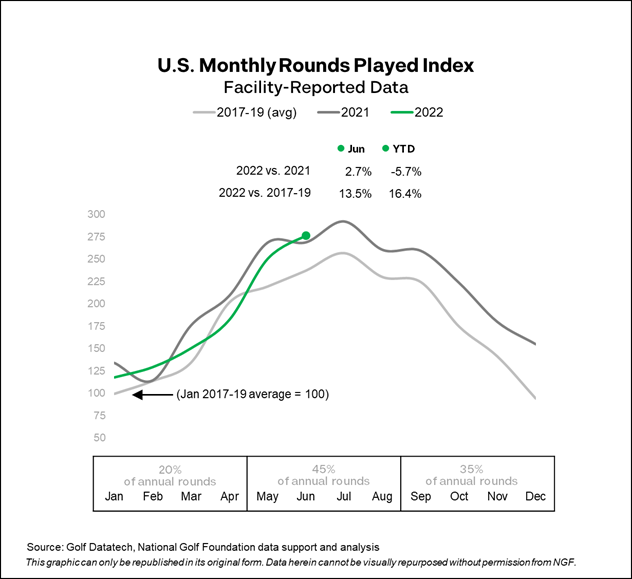We’re now two full years into the Covid golf renaissance — as marked not by the onset of the virus, but in terms of the broad lifting of any operational restrictions by mid-summer of 2020.
A question we hear fairly often is: How much have rounds increased during the Coronavirus era?
There’s nuance in that inquiry, the gist of which is really this: When it comes to play, what’s been the Covid dividend?
With the June 2022 national rounds report out, we now have a full 24 months of supporting data since golfers have been unencumbered by pandemic restrictions.
Play in 2022 hasn’t matched the momentum in 2021, a year that saw more rounds of golf than any in history, with year-over-year declines in four of the first six months. But this year’s “drops” in play don’t tell the whole story, or fully recognize the strong demand that still exists, broadly speaking.
When taking the latest 12-month rolling totals for rounds – the second half of 2021 and the first six months of this year – play at U.S. golf courses is up 10% compared to the 10-year average. In comparison to only recent pre-pandemic years (2013-19), play over the past 12 months is up 13%.
The “Covid bump” is even more significant when looking at the years immediately preceding the onset of the coronavirus.
Consider that 2018 and 2019 were among the four-wettest years in the continental U.S. dating back to 1895, according to the National Oceanic and Atmospheric Administration. Weather has a significant impact on engagement when it comes to an outdoor, pay-to-play game like golf, and those back-to-back years of more unfavorable golf conditions contributed to the fewest rounds being played at U.S. courses since 1996 – the year before Tiger Woods really burst onto the scene with his breakthrough Masters Tournament win and spurred surges in golf participation.
In turn, the Covid-driven surges in play that began in late 2020 and extended through 2021 were buoyed, at least in part, by extremely favorable golf weather. In many ways, it was the perfect storm for golf – no pun intended – with people clamoring to get outside, fewer competing activities, limited travel AND generally good weather for golf. The result was more rounds-played nationwide than at any time in history.
The question coming into 2022 was whether that record-setting momentum would continue or how much of a regression there would be.
For some participants, we’ve seen the inevitable return to other activities that compete for discretionary time and dollars. But indications are that less-favorable golf weather may thus far have had more of an impact on this year’s slight dips in play than any substantial tapering of demand.
Total “playable hours” were down about 9% at the midway point of the year, per Pellucid Corp.’s latest National Weather Impact Report. And some of the most notable declines in Pellucid’s playable hours metric were in the best-supplied golf markets: the Northeast, Great Lakes, Ohio Valley and northern and central Texas regions all have seen YTD decreases in excess of 10%.
Perhaps not surprisingly, the nationwide downturn in playable hours is directionally similar to the YTD data points in the latest rounds report from Golf Datatech and NGF. Compared to a year ago, overall play through June was -6% at public golf facilities and -5% at private clubs.
Despite trailing last year’s midyear pace, 2022 play totals remain ahead of the recent pre-pandemic averages.

And there are still indicators of strong demand across the industry.
GolfNow, the largest online tee-time marketplace with over 6,000 golf courses in the U.S., has seen a 52% increase in its online bookings over the past two years. This reflects both the GolfNow and TeeOff websites as well as the booking engines GolfNow provides to golf course partners that allow golfers to book directly through individual facility websites.
Online searches for golf balls show continued stabilization above previous norms. And this is a metric that historically has strongly correlated with play, as golf balls are the game’s ultimate consumable.
Looking ahead, the remaining six months of play data for 2022 will actually have a greater impact on the year-end total. Approximately 53% of annual rounds are played from July through December.





